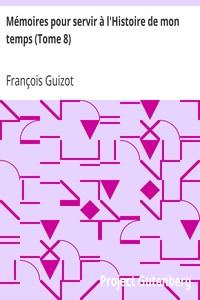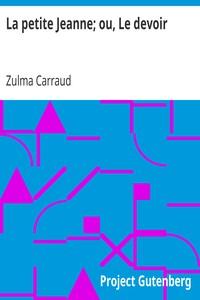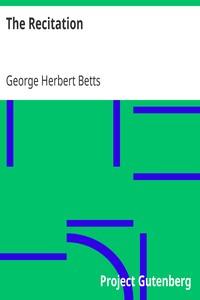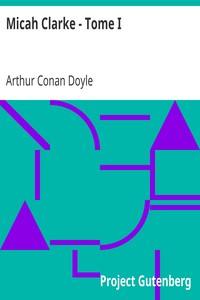Read this ebook for free! No credit card needed, absolutely nothing to pay.
Words: 28862 in 11 pages
This is an ebook sharing website. You can read the uploaded ebooks for free here. No credit cards needed, nothing to pay. If you want to own a digital copy of the ebook, or want to read offline with your favorite ebook-reader, then you can choose to buy and download the ebook.
EDITOR'S INTRODUCTION
OUTLINE
EDITOR'S INTRODUCTION
Teachers are not always clear as to what they mean when they speak of the recitation. Many different meanings are associated with the term. Some of these are suggestive but quite vague; and others, although more definite, are but partial truths that hinder as much as they help. It is not surprising that a confused usage of the term is current among teachers.
From one point of view, the recitation is a recitation-period, a segment of the daily time schedule. In this sense it is an administrative unit, valuable in apportioning to each school subject its part of the time devoted to the curriculum. Thus, we speak of five recitations in arithmetic, three in music, or two in drawing, having in mind merely the number of times the class meets for instruction in a particular school study. A recitation here means no more than a class-period, a more or less arbitrary device for controlling the teacher's and pupils' distribution of energy among the various subjects taught.
From another point of view, the recitation is a form of educative activity rather than a mere time allotment. In this sense the recitation is a process of instruction, a mode of teaching, wherein pupils and teacher, facing a common situation, proceed toward a more or less conscious end. It is a distinct movement in classroom experience, so organized that a definite beginning, progression, and end are clearly distinguishable. Thus we speak of the method of the recitation, the five formal steps of the recitation, or the various types of recitation. Such a usage makes "recitation" synonymous with "lesson." Indeed, when we pass from general pedagogical discussion to a detailed treatment of special methods of teaching, we usually abandon the term "recitation" and use the word "lesson." Although there is always some notion of a time-period in the curriculum in our idea of a lesson, yet the term "lesson" is more intimately connected with the thought of a teaching exercise in which ideas are developed and fixed in memory. It is through the lesson or recitation that pupils and teachers influence one another's thought and action; and when this condition exists, there is always educative activity.
These two ways of thinking of the recitation, one primarily administrative and the other primarily educative, need to be somewhat sharply differentiated in our thinking. However closely related they are in actual schoolroom work, however greatly they influence each other in practice, they require a theoretic separation. Only by this method can we avoid some of the error and confusion current in teaching theory and practice. A single instance will suffice to show the value of the distinction.
No one of us would deliberately assume that the teaching process required for the instruction of a child would just cover the twenty, thirty, or forty minutes allotted to the class-period, day after day and year after year, regardless of the subject presented or the child taught. Yet this is precisely the sort of assumption that is implied throughout a considerable portion of our current discussion of the teaching process. We talk about a "developmental-lesson" or a "review-recitation" in, say, geography, as though it began and ended with the recitation-period of the day. The daily lesson-plans we demand of apprentice-teachers in training-schools are largely built upon this basis.
Of course the fact that one must begin a theme at a given moment and close at a similar arbitrary point affects the teacher's procedure somewhat. He will always have to attack the problem anew at ten o'clock and pull together the loose ends of discussion at ten-thirty, if these happen to be the limits of time assigned him. But who will be bold enough to assert that the psychological movement for the development and solution of the particular problem at hand will always be exactly thirty minutes long? It is possible, and quite probable, that the typical movements in instruction--development, drill, examination, practice, and review--may occur within a single class-period, following fast upon the heels of each other as the situation may demand. It is equally probable that in many cases any one of them may reach across several class-periods. We need a more flexible way of thinking of the recitation and of the teaching activities involved in class-periods and of other administrative factors which condition the effectiveness of teaching.
Such a clear, flexible treatment of the recitation is offered in this volume. We feel that it will be particularly welcome to the practical teacher since so many previous treatments of this subject have been formal or obscure. Combining the training of a psychologist with the experience of a class teacher, Professor Betts has given us a lucid, helpful, and common-sense treatment of the recitation without falling into scientific technicality or pedagogical formalism.
THE PURPOSES OF THE RECITATION
The teacher has two great functions in the school; one is that of organizing and managing, the other, that of teaching.
Free books android app tbrJar TBR JAR Read Free books online gutenberg
More posts by @FreeBooks

: The Olden Time Series Vol. 6: Literary Curiosities Gleanings Chiefly from Old Newspapers of Boston and Salem Massachusetts by Brooks Henry M Henry Mason - New England Social life and customs; Literary curiosa
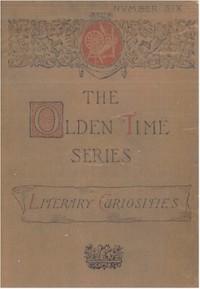

: Mémoires pour servir à l'Histoire de mon temps (Tome 8) by Guizot Fran Ois - France Politics and government 1814-1830; France Politics and government 1830-1848; Guizot M. (François) 1787-1874; France Foreign relations 1815-1848 FR Biographie Mémoires J
